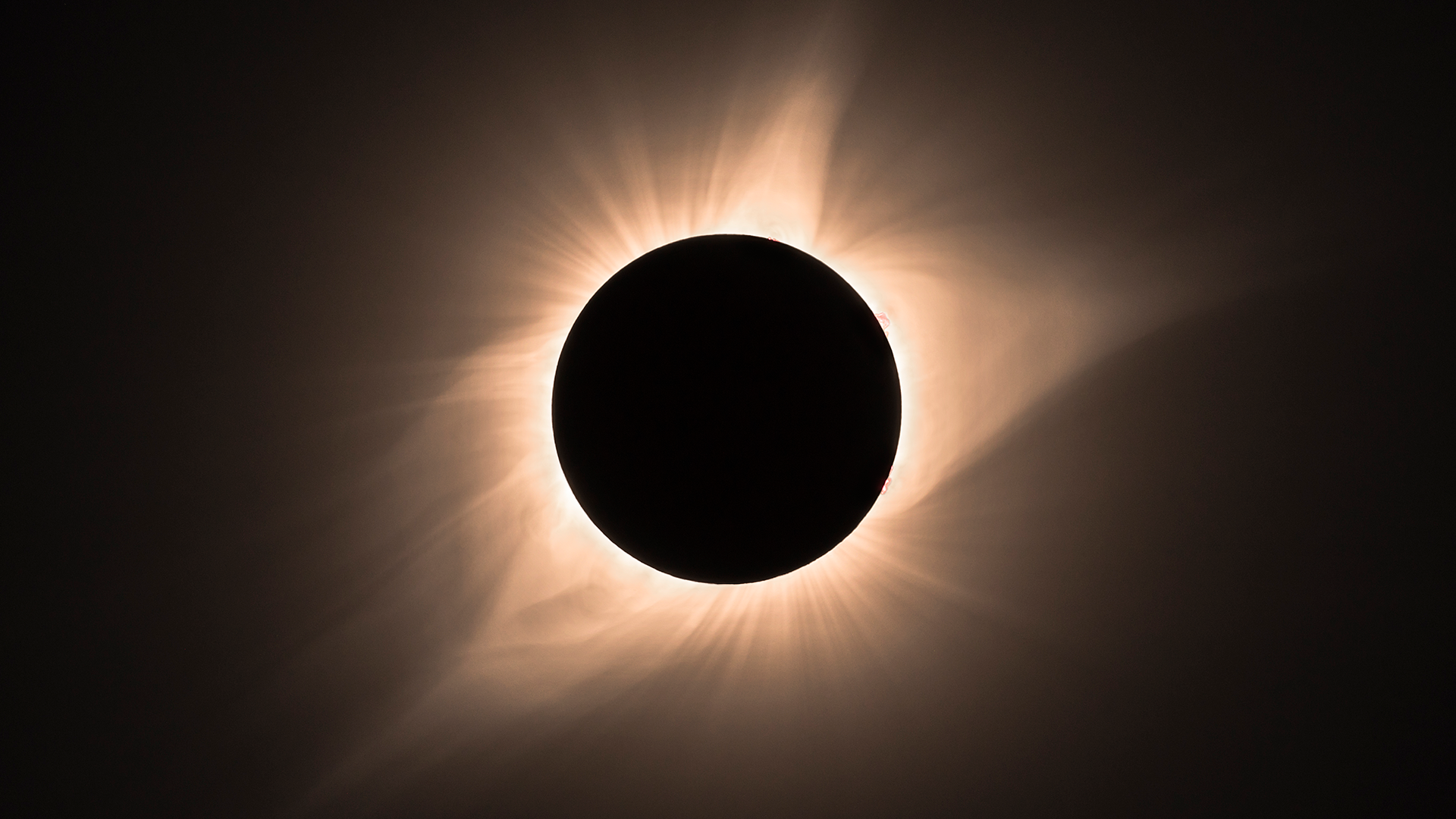On April 8, millions of people across North America will be treated to the sight of a total solar eclipse, during which the Moon will slide in front of the face of the Sun, temporarily blocking its light, and bathing our planet it shadow.
Read on to discover everything that you need to know about this rare cosmic event, including timings, the location of the path of totality, how to stay safe when viewing the eclipse in person, and where you can find a live-stream of the event online.
What time is the eclipse on Monday
The April 8 total solar eclipse will begin over the South Pacific Ocean, before going on to sweep across a swath of Mexico, the U.S, and Canada. While the event will be visible to some degree across the entirety of America, only a relatively thin strip of the continent will have the chance to see the Moon completely cover the Sun’s disk.
This region, known as the ‘path of totality’ lies directly ‘underneath’ the Moon relative to the Sun, and is where the darkest part of the shadow, known as the umbra, will fall. Mexico’s Pacific coast is set to be the first region to experience totality at around 11:07am PDT / 2:07pm ET. Soon after, at 11:30am PT / 2:30pm ET the vast umbra will sweep across the path of totality, moving through parts of Texas, Oklahoma, Arkansas, Missouri, Illinois, Kentucky, Indiana, Ohio, Pennsylvania, New York, Vermont, and New Hampshire, before finally reaching Maine at 12:30pm PT / 3:30 ET.
Along the way, the lunar shadow will engulf a number of cities, including Dallas, Cleveland, and Buffalo. After leaving the U.S, the eclipse will be visible from parts of Canada including Southern Ontario, Quebec, New Brunswick, and Cape Breton, before finally passing out into the Atlantic ocean at 5:16 NDT.
If you’re in North America, then be sure to check out NASA’s handy Eclipse Explorer interactive map, which can help you discover the extent to which the eclipse will be visible in your area, along with the exact times at which the different stages will occur.
What to expect during the 2024 North American total solar eclipse
Those hoping to see every stage of the April 8 eclipse will need to put themselves directly in the path of totality, as detailed above. The earliest stage of an eclipse is known as ‘first contact’ wherein the Moon’s disk first begins to overlap the fiery surface of Earth’s star. From here, the Sun will begin to take on a crescent shape, as the two orbs move ever closer to alignment.
In the final moments leading up to totality, viewers should be on the lookout for transient visual phenomenon. For example, you may be able to pick out bright points of light dotting the Moon’s horizon. These points — known as Baily’s Beads — manifest when the lunar disk has almost entirely swallowed up the Sun, allowing just a few points of light to shine through the valleys that line the Moon’s surface.
At around the same time observers may also be able to spot subtle ripples of light and dark dancing across the ground. These so-called ‘shadow bands’ are thought to be triggered as the final rays of sunlight peeking around the Moon’s profile are disturbed by Earth’s atmosphere.
Next comes the moment that every eclipse gazer has been waiting for - the period of totality, in which the Moon blocks out the face of the Sun, bathing the Earth beneath in a false dusk. This stellar crescendo — also known as second contact — can last between two to four minutes, depending on how close a person is to the centre of the path of totality.
As the shadow passes over and the temperature falls, onlookers will be treated to a sight of the Sun’s atmosphere radiating out from behind the Moon’s disk. The chromosphere will hopefully be visible as a pink circle outlining the Moon, while the corona should be visible as streams of white light.
Bright stars and planets may also become visible in the darkened sky. During previous eclipses, observers have also reported that totality is accompanied by a strange silence, as those around paused to take in the spectacle, and wildlife reacted to the sudden change.
Those outside of the path of totality will still be able to witness a partial eclipse, in which the Moon’s disk occults a part of the Sun’s surface, and everyone else will be able to watch the entire spectacle unfold on the internet courtesy of NASA, and some interesting partnerships, but more on that later.
Which glasses you need to protect your eyes during the eclipse
Earth’s star fuses 600 million metric tons of hydrogen fuel each and every second in a process that creates a vast amount of excess radiation, which we perceive as intense light, and heat. As a result, staring directly at it for just a few seconds without the proper protective eyeware or filters can literally burn a hole in your retinal tissue, causing permanent damage to your vision.
Thankfully, there are a number of ways that you can watch the April 8 total solar eclipse unfold without putting your vision at risk, and before you ask, no, regular sunglasses simply won’t cut it. If possible, we recommend that you get your hands on a pair of authentic solar viewers or filters for binoculars, links to which can be found on the American Astronomical Society website.
Note that the society has warned that bad actors may be selling counterfeit eclipse glasses online, and so has cautioned against buying protective eyewear via marketplaces like Amazon, eBay, or Temu. For more details on how to spot a fake, please check out this page.
Alternatively, you could observe the eclipse indirectly by projecting it using a pinhole projector, which, as the name suggests, projects an image of the Sun onto a surface for safer viewing. A step by step guide to making a pinhole projector can be found here.
Protective gear can be briefly set aside during totality, when the face of the Sun is completely obscured by the Moon, but must be immediately put on when brightening occurs. Check out this page for a comprehensive list of NASA's eclipse safety guidelines.
How to watch the North American total solar eclipse online
NASA is providing a live-stream of the April 8 eclipse from 1:00 p.m. to 4:00 p.m. EDT through YouTube, NASA TV, via the NASA+ app, and on Twitch, which will feature real-time telescope footage paired with expert commentary on the science behind the event.
The agency is also offering a Spanish language version of the broadcast, along with a clean, commentary-free feed of the eclipse provided by partners, which will show footage of the Sun in different wavelengths of light. The National Esports Association has also partnered with NASA, Twitch, Microsoft, and Epic Games to allow students to create special eclipse-themed versions of Fortnite, and Minecraft.
Footage of the games will be streamed alongside live NASA footage of the eclipse on April 8 from 2:00 to 4:00 p.m. EDT, using the platform’s Stream Together feature, which allows up to five creators to collaborate and feature each other’s streams during live broadcasts.
What is a total solar eclipse?
Our solar system, and the universe beyond it, is alive with activity. Moons circle planets, which orbit stars, which in turn traverse around the galactic centre of the Milky Way, which is itself a partner in a grander dance that will see it collide with the Andromeda galaxy some five billion years from now.
These motions are all too often obscured by the vast cosmic distances that seperate the heavenly bodies, and the drawn out timescales on which they play out. However, every so often, we are given the opportunity to witness the incredible scale and complexity of the orbital mechanics at work in our planetary system in the form of a total solar eclipse.
Eclipses occur when the Moon passes directly between Earth and our parent star, occulting much of the Sun’s light, and bathing our planet in its shadow. Similar events are also known to take place on other worlds, including Mars. However, Earth is unique in our Solar System as the only planet with a moon capable of triggering a total solar eclipse, wherein the disk of the Sun is entirely blocked by the traversing body.
Such a cosmic event is possible thanks to the fact that the Moon - which is some 400 times smaller than the Sun — also just so happens to be 400 times closer to Earth when compared to our parent star. As a result of this cosmic coincidence, the two bodies appear roughly the same size from the surface of our planet, allowing the Moon to totally block the incandescent disk of the Sun on the rare occasions when the two align in Earth’s sky.
Eclipses are particularly rare owing to the fact that the Moon orbits on a five degree tilt relative to the orbital plane that Earth traverses around the Sun, known as the ecliptic. As a result there are only two times of the year when the Moon lines up to eclipse the light of the Sun.
Following next week's event, North America won't see another total eclipse until August 23, 2044, at which point NASA and its partners are hoping to have established a crewed colony on the Moon as part of its ambitious, and delay fraught Artemis program. For more science coverage, why not read about how a U.S. company performed a Mac-Gyver-tier fix to land its spacecraft on the Moon, or find out about the astronauts who will be travelling to lunar space when the Artemis II mission launches in September 2025.
Anthony is a freelance contributor covering science and video gaming news for IGN. He has over eight years experience of covering breaking developments in multiple scientific fields and absolutely no time for your shenanigans. Follow him on Twitter @BeardConGamer







